鶴岡八幡宮(鎌倉)/ Tsurugaoka Hachimangu Shrine (Kamakura)
鎌倉を代表する「鶴岡八幡宮」。「鎌倉江の島七福神」の「弁財天」目的で来たが、やはり奥深い。/ “Tsurugaoka Hachimangu” is represented in Kamakura. I came here for the purpose of “Benzaiten” of “Kamakura Enoshima Seven Lucky Gods”. Here has deep history for me.
「鶴岡八幡宮」は、鎌倉観光の定番です。私も毎年新年のお参りをしているので来た回数は数えきれません。
“Tsurugaoka Hachimangu” is a standard sightseeing spot in Kamakura. I also visit the New Year every year, so I can’t count the number of times I have come.
「鶴岡八幡宮」(Wiki)(HP)は、鎌倉を訪れたら、必ず訪れたい場所です。
“Tsuruoka Hachimangu” is a place you should definitely visit if you visit Kamakura.
そういう「鶴岡八幡宮」ですが、「鎌倉江の島七福神」の「弁財天」に参るのは初めてです。新年の祈願と違って、人が随分と少ないので、今まで見ていなかったところもじっくり見ることができました。
It is such “Tsurugaoka Hachimangu”, but it is the first time to visit “Benzaiten” of “Kamakura Enoshima Seven Lucky Gods”. Unlike New Year’s pray, there are so few people, so I was able to see places I had never seen before.
■目次 / Contents
- 鎌倉駅~小町通り / Kamakura Sta. and Komachi street
- 段葛(表参道)/ Dankatsura (Approach)
- 鶴岡八幡宮の境内 / Precincts of Tsurugaoka Hachimangu
- 旗上弁財天社 / Hataage Benzaiten Sha
- 自お祓い / Self-Purification
- 舞殿と手水舎 / Maiden and Temizuya
- 鶴岡八幡宮 / Tsurugaoka Hachimangu
- 丸山稲荷社 / Maruyama Inari Shrine
- 若宮(下宮) / Wakamiya
- 白旗神社 / Shirohata Shrine
- 今宮 / Imamiya
- まとめ / Summary
■鎌倉駅~小町通り / Kamakura Sta. and Komachi street
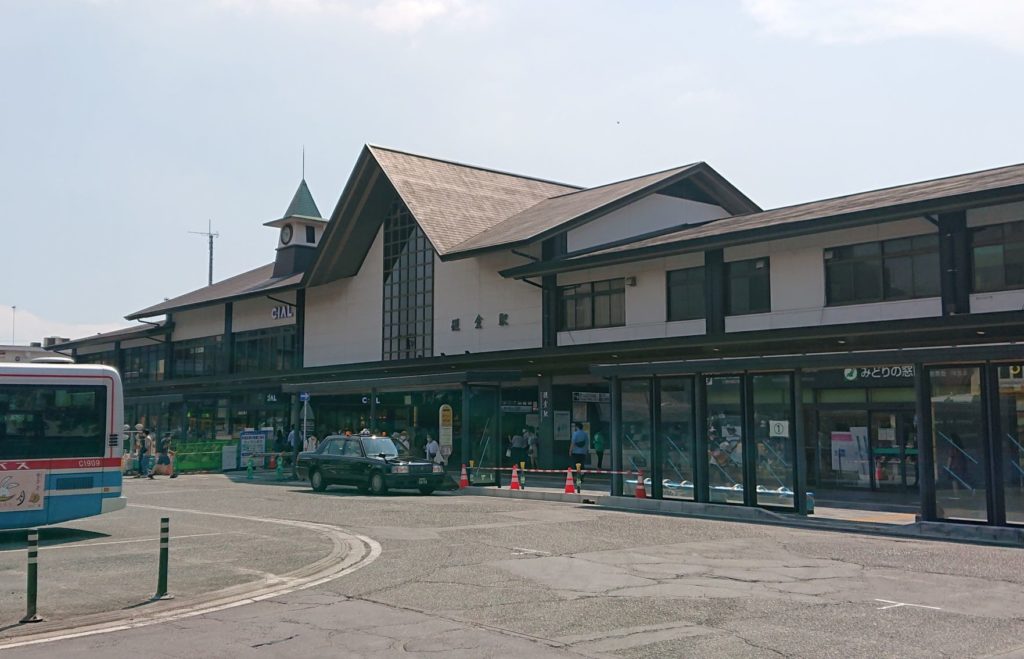
「鎌倉駅」から出発です。駅舎も数年前にリニューアルし、お土産などのショッピングができるようになりました。
It starts from “Kamakura Station”. The station building was renewed a few years ago, and now you can shop for souvenirs.
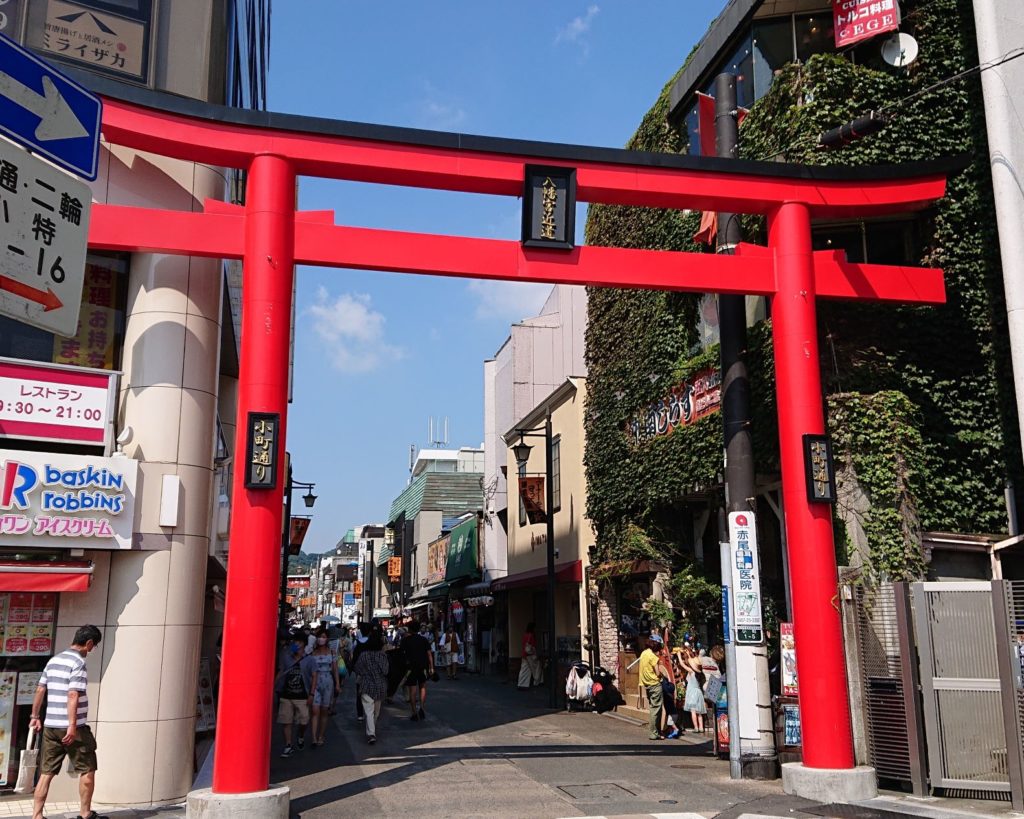
「小町通り」の入口。鳥居の上のプレートには、「八幡宮近道」と書いてあります。ここ「小町通り」は、表参道ではないのですが、レストラン、お土産屋、昔ながらのお肉屋など様々なお店が立ち並んでおり、ちょっと来ない間にお店が変わっていたりします。鎌倉を訪れたら一度は通ってみたい通りです。
The entrance to “Komachi-dori (street)”. The plate above the torii says “Hachimangu shortcut”. Although “Komachi-dori” is not Omotesando (an approach to Hachimangu), there are various shops such as restaurants, souvenir shops, and old-fashioned butcher shops, so the shops may change before you come. If you visit Kamakura, It is better you go through this street once.
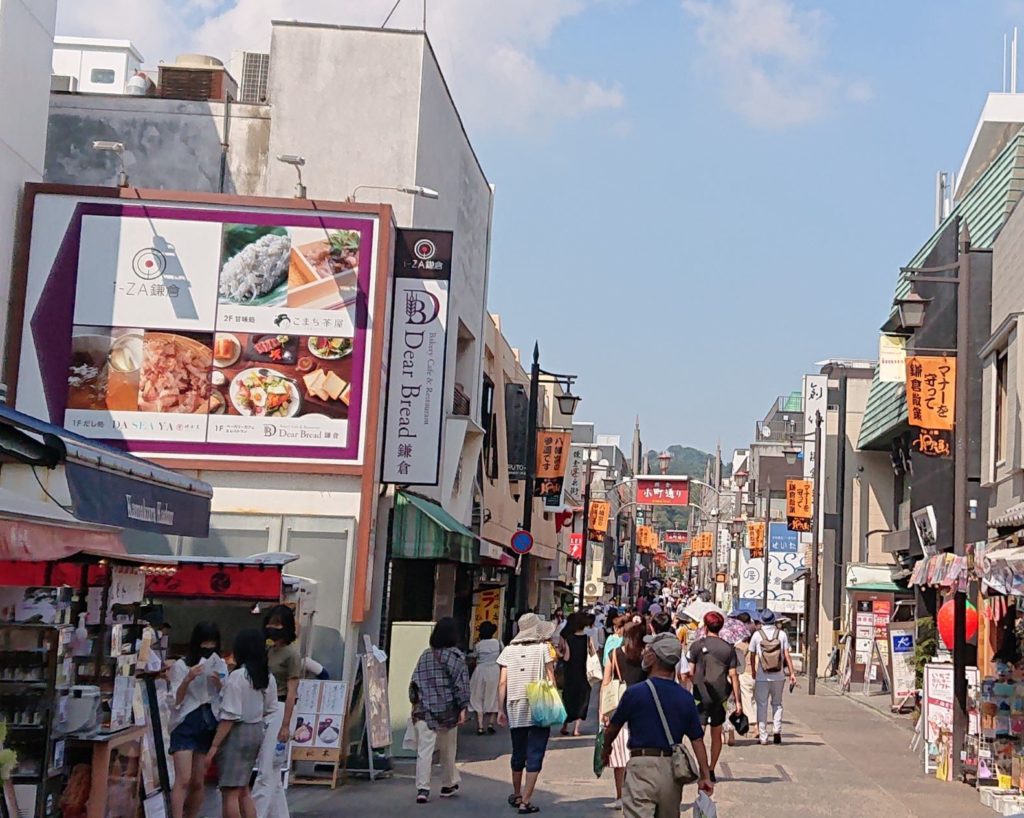
この日の人出は、3割程度。自分のペースで歩くことができます。夏なので、浴衣を着た男性女性を目にすることができます。浴衣、着物の貸衣装屋も最近注目されているようです。
The crowd on this day is about 30% than that of before Corona virus. You can walk at your own pace. Since it’s summer, you can see men and women wearing Yukata, Japanese traditional wear in summer. It seems that Yukata and Kimono rental shops have recently been attracting attention.
■段葛(表参道)/ Dankatsura (Approach)
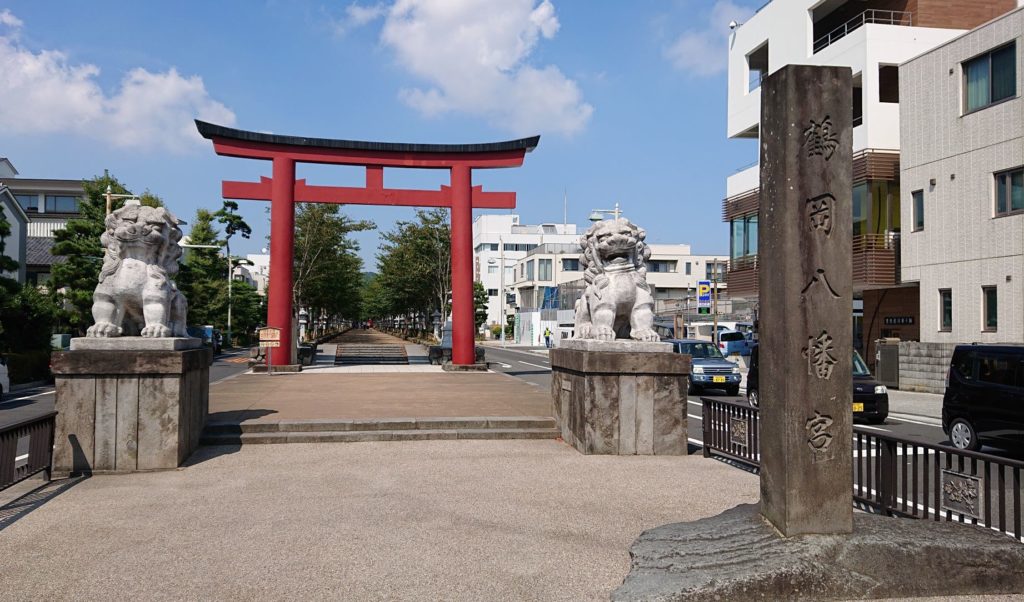
「小町通り」に入って1つ目の交差点を右に曲がると、「鶴岡八幡宮」の「表参道」の「段葛」(Wiki)の入口に出ます。鶴岡八幡宮の参道、若宮大路の「一の鳥居」は、約800m海側に有ります。ここは「二の鳥居」。
Turn right at the first intersection after entering “Komachi-dori” and you will come to the entrance of “Dankazura” of “Omotesando (approach)” of “Tsurugaoka Hachimangu”. The “the first Torii” of Wakamiya Daiji (roadway), the approach to Tsurugaoka Hachimangu, is about 800m on the sea side. This is the “the second Torii”.
いつもなら、多くの人が写真撮影を順番に撮影している場所ですが、この日は、ちょっと待つと、全く人が居ない状態になりました。
Usually, it’s a place where many people take pictures one after another, but on this day, after a short wait, there was no one at all.
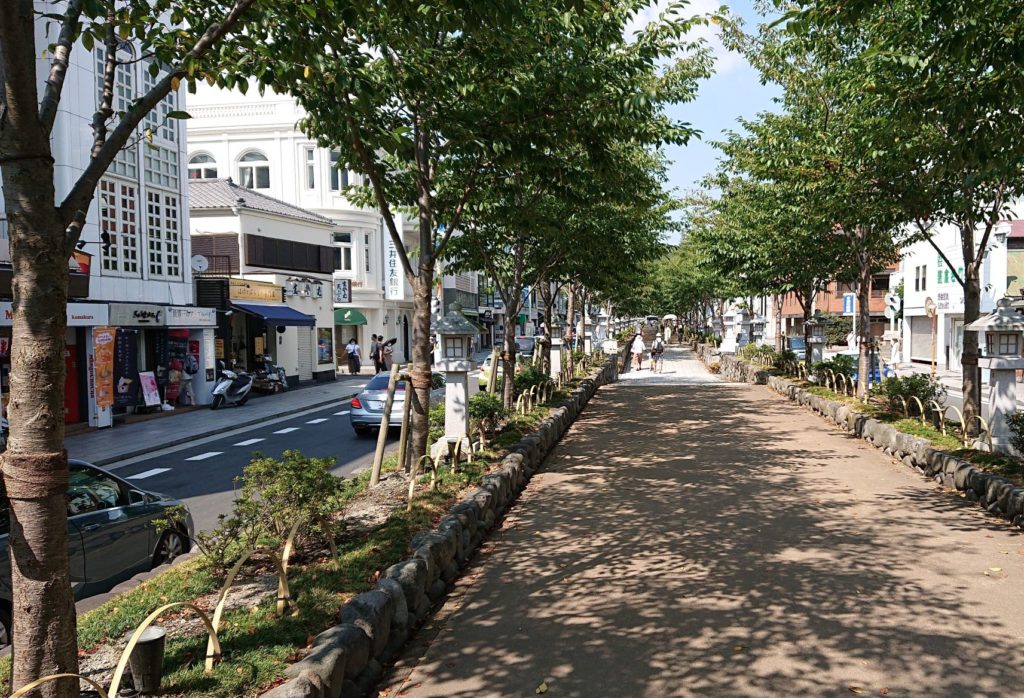
段葛は、桜並木の名勝です。全長約500m。左右の若宮大路(車道)から50㎝くらい高くなり歩行者専用の路になっています。段葛は、2016年に作りなおされ、砂から土色のコンクリートや石ブロックになりました。
“Dankuzura” is a scenic spot of cherry blossom trees. The total length is about 500m. It is roads for pedestrians, about 50 cm higher than the Wakamiya Oji (roadway) on both sides. “Dankuzura” was rebuilt in 2016 and turned from sand to earth-colored concrete and stone blocks.
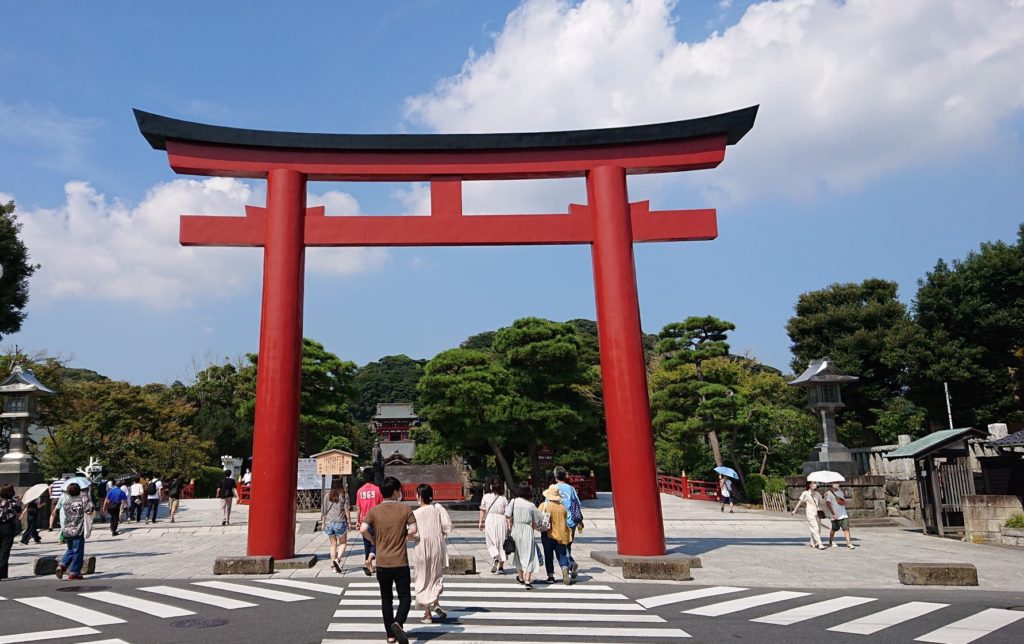
「三の鳥居」を過ぎると、境内に入ってきます。この箇所から鳥居の向こう側に、「鶴岡八幡宮」が「太鼓橋」と共に見ることができます。
After passing the “the third Torii”, you will come into the precincts. From this point, you can see both “Tsurugaoka Hachimangu” and “Taikobashi (arched bridge)” over the torii gate.
■鶴岡八幡宮の境内 / Precincts of Tsurugaoka Hachimangu
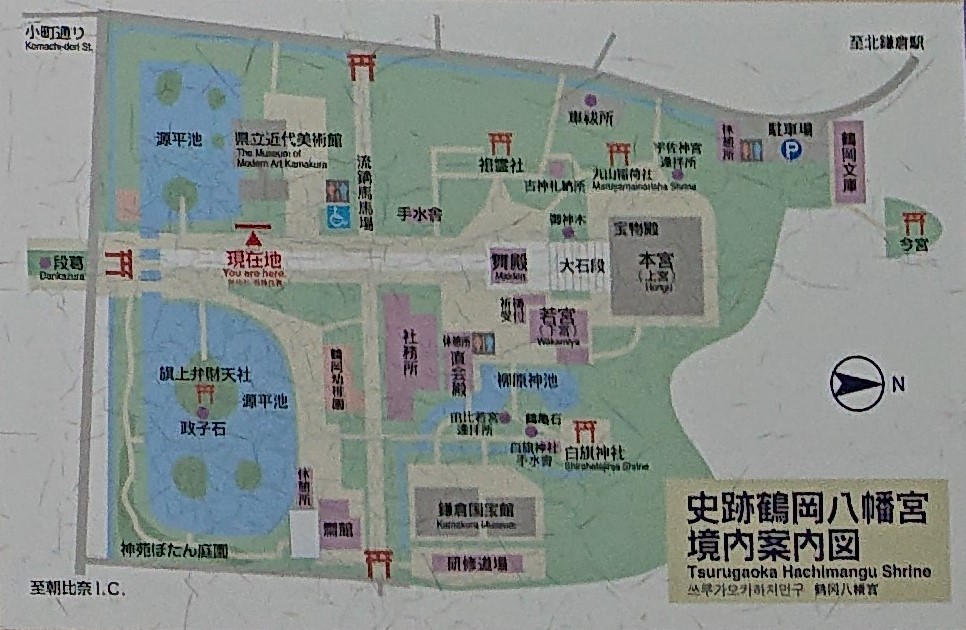
これは、境内の案内地図です。この地図を見ながら境内を見学してください。
This is a guide map of the precincts. Please visit the precincts while looking at this map.
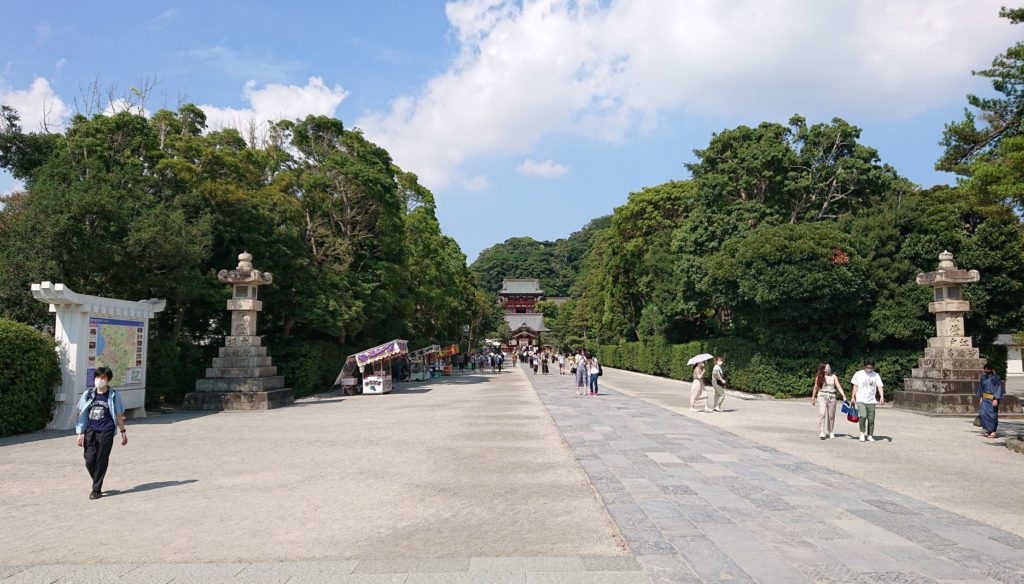
「鶴岡八幡宮」の境内です。約200m歩くと「舞殿」、そこから50m(ほどんどが階段)で「鶴岡八幡宮」になります。この日は、人も少ないですが、お正月には、下の写真のように、人の頭しか見えない状態になります。
It is the precincts of “Tsurugaoka Hachimangu”. If you walk about 200m, you will reach “Maiden” and 50m (mainly stairs) to “Tsurugaoka Hachimangu”. There are not many people on this day, but during New Year’s Day, only the human head can be seen, as shown in the photo below.
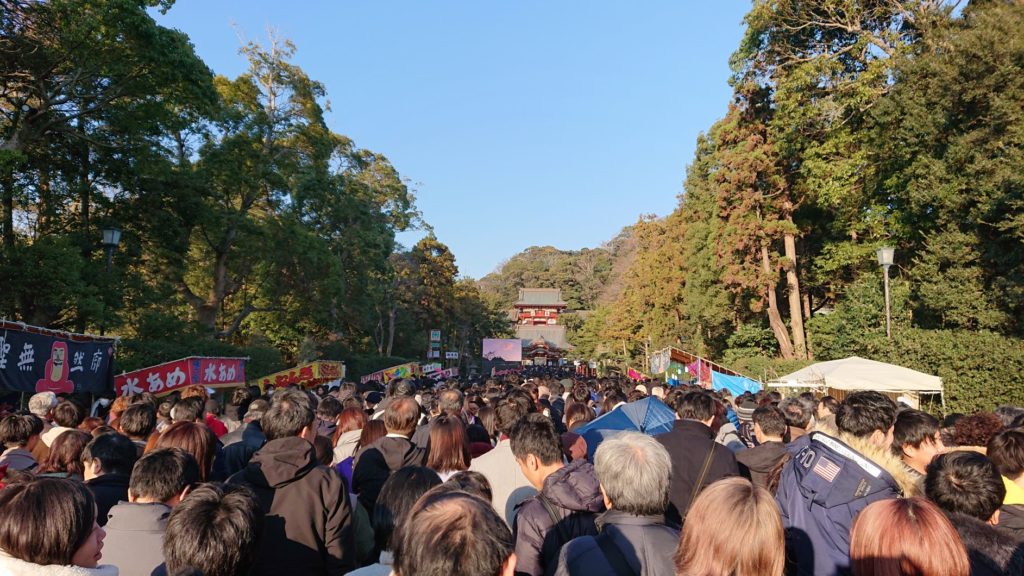
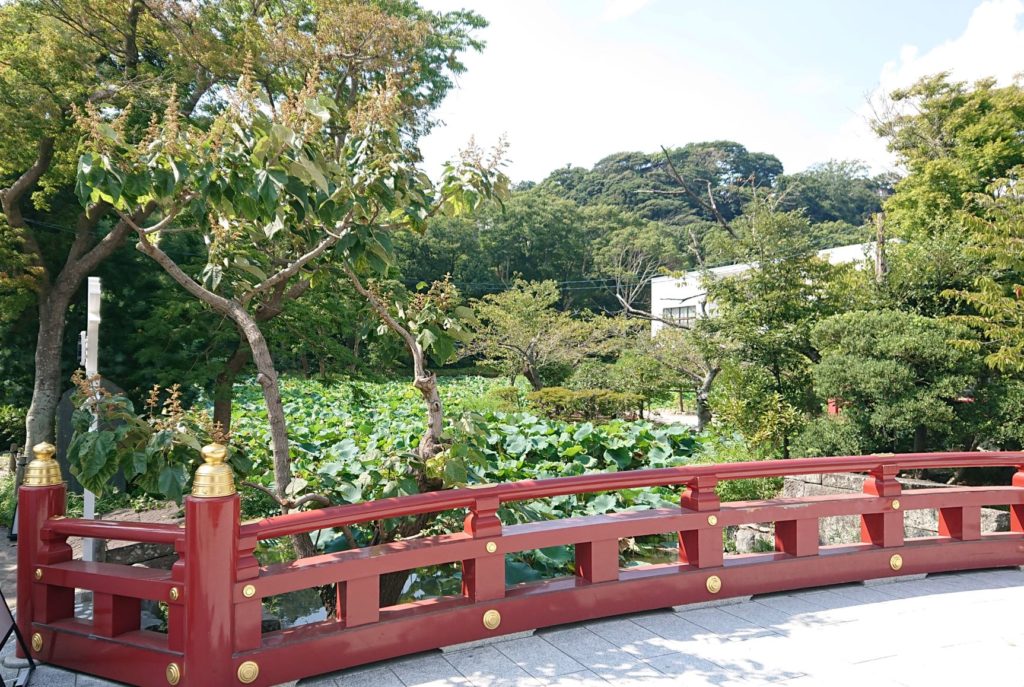
「鶴岡八幡宮」に向かって左側が「平家池」で、昔は紅色の蓮が咲いていたと言われています。この時期は、蓮の花には少し遅かったようです。右手には、美術館の建物が見えます。
“Heike Pond” is on the left side of “Tsurugaoka Hachimangu”, and it is said that red lotus used to bloom in the past. It seems that lotus flowers were a little late at this time. You can see a bit of the museum building on your right on this picture.
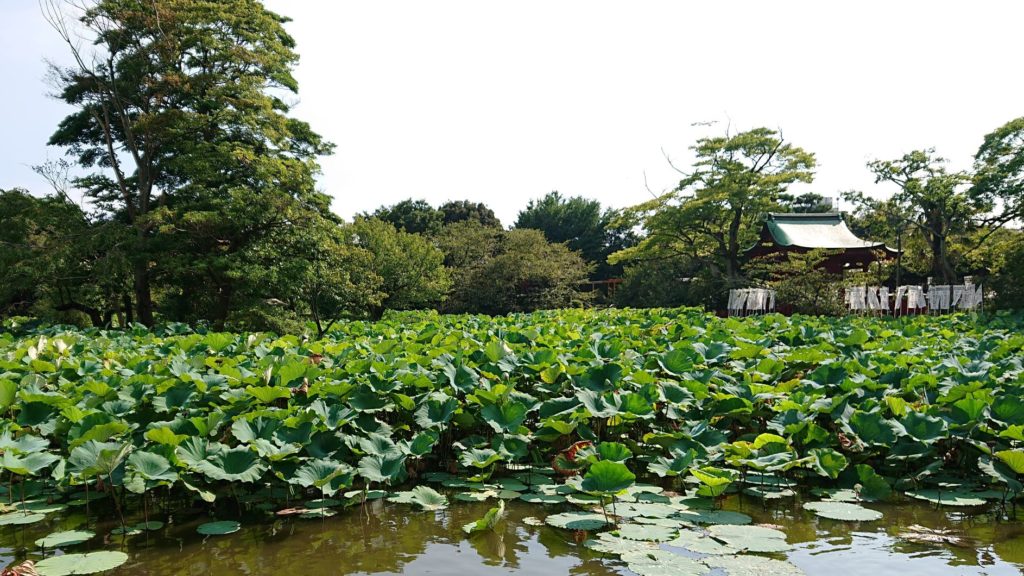
「鶴岡八幡宮」に向かって右側が「源氏池」で、太鼓橋の下で「平家池」と繋がっています。こちらは、白色の蓮が植わっていたとされています。池向こうに見えるのが「旗上弁財天社」の浮島です。橋で繋がています。
The “Genji Pond” is on the right side of “Tsurugaoka Hachimangu” and is connected to “Heike Pond” under “Taikobashi (arched bridge)”. It is said that white lotus was planted here. Beyond the pond is the floating island of “Hataage Benzaten”. You can go there by walking on a bridge.
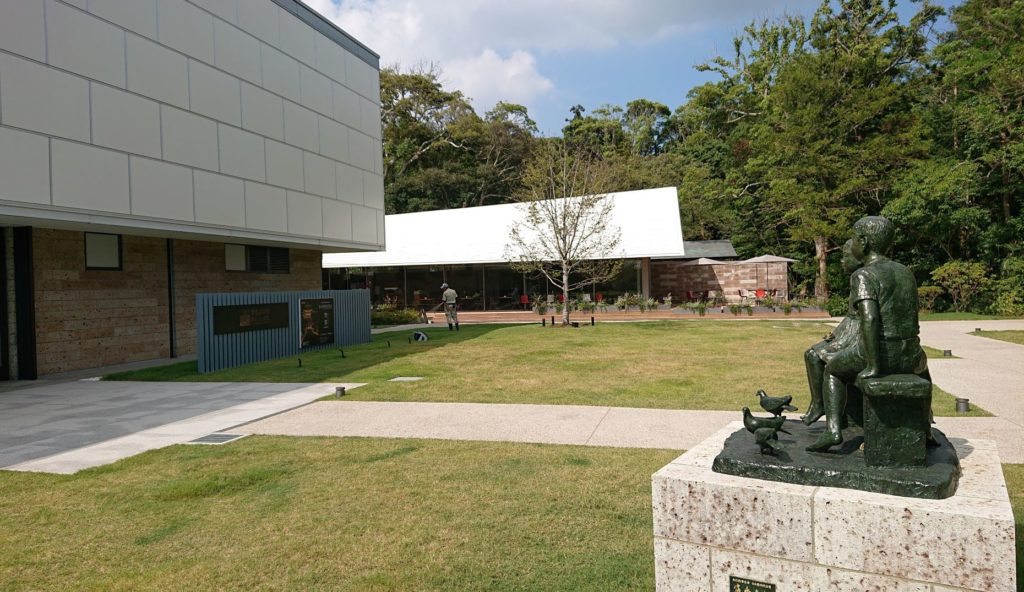
手前が美術館の建物で、「平家池」に隣接しています。向こうが、レストランとショップの建物です。結構おしゃれで開放的な建物です。テラス席で、お茶などが出来るようです。
The museum building is in the foreground and is adjacent to the Heike Pond. Over there is a restaurant and shop building. It is a rather stylish and open building. It seems that you can have tea on the terrace.
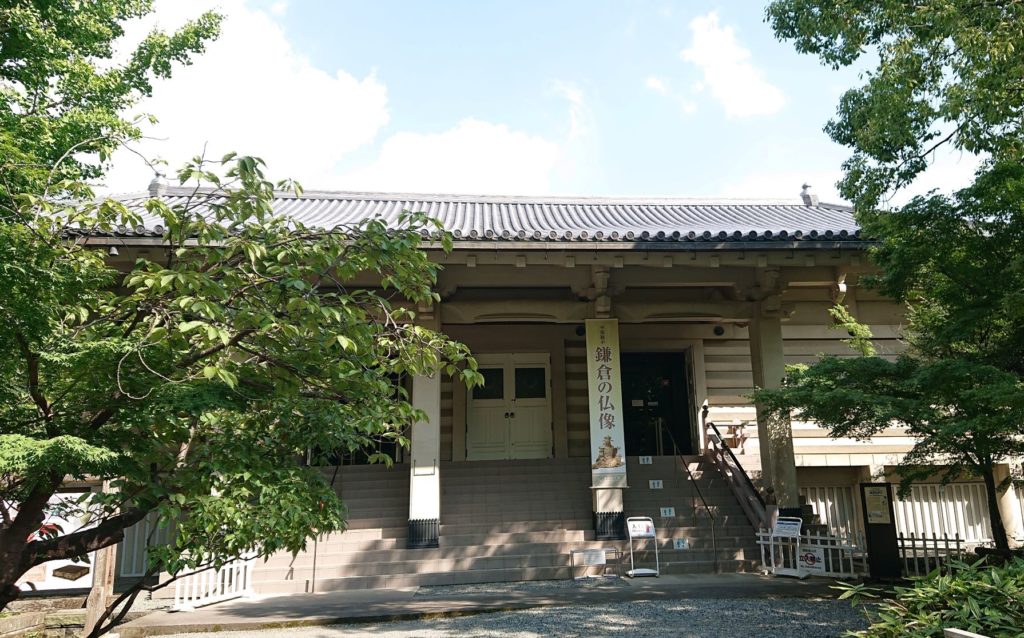
「鎌倉国宝館」です。「白旗神社」の参道沿いにあります。
It is “Kamakura National Treasure Museum”. It is located along the approach to Shirohata Shrine.
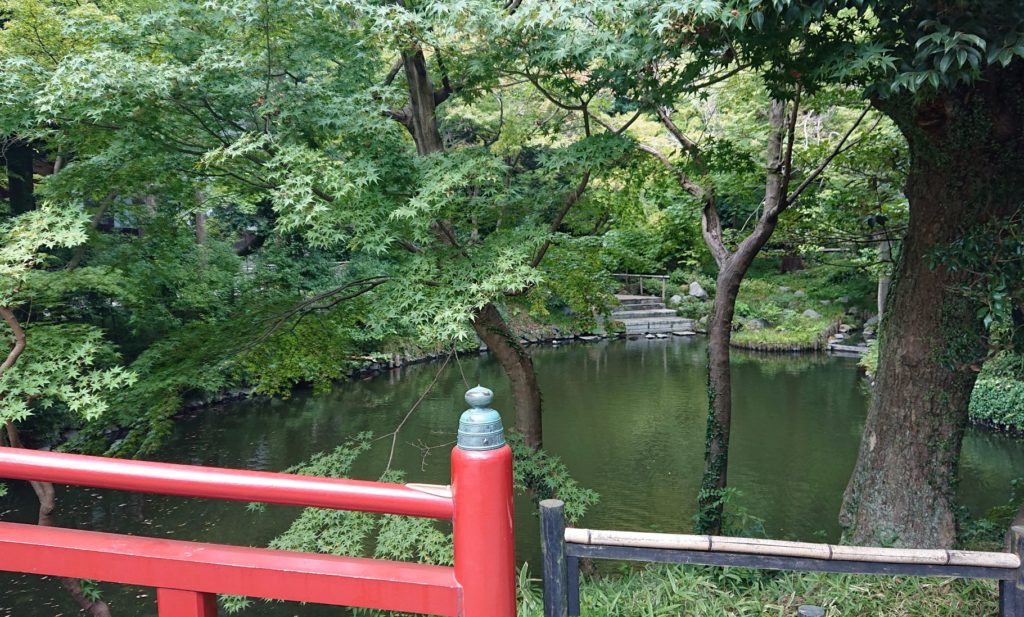
「若宮」前から「白旗神社」への道中に、「柳原神池」があります。紅葉が池に覆いかぶさっています。秋には是非紅葉を楽しみたいですね。
There is “Yanagihara Kamiike (pond)” on the way from “Wakamiya” to “Shirohata Shrine”. Autumn leaves cover the pond. I really want to enjoy the autumn colors in autumn.
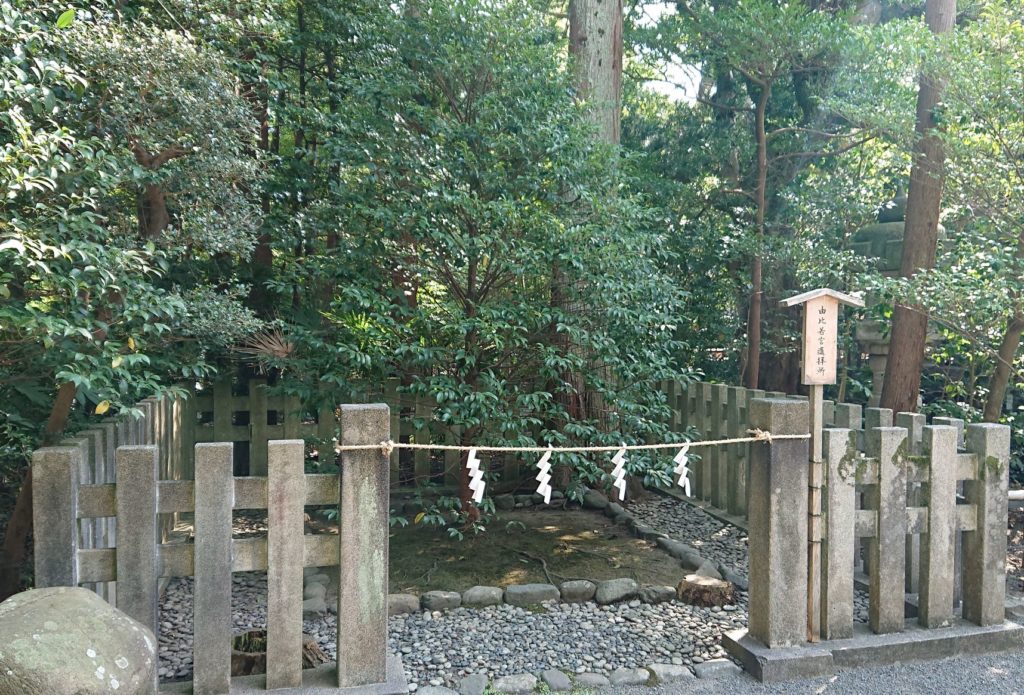
「由比若宮逢拝所」は、「柳原神池」を過ぎた所にあります。鎌倉材木座(約2km海側)に「由比若宮」(鶴岡八幡宮元宮)があります。平安時代に河内源氏、源頼義が”前九年の役”で東北に赴く際、この地に石清水八幡宮をお祀りしました。その後、この地に移されたため、今では、「元八幡」と言われています。この「由比若宮逢拝所」でお参りすると、鎌倉材木座にある「由比若宮」をお参りすることになるという場所です。
The “Yui Wakamiya Yohaijo” is just past “Yanagihara Kamiike (pond)”. There is “Yui Wakamiya” (Tsurugaoka Hachimangu Motomiya) in Kamakura Zaimokuza, about 2 km from here. During the Heian period, when Yoritomo Minamoto, Genji Kawachi, went to Tohoku for “Zen 9 nen no Eki (the war of Zen ninth year)”, Iwashimizu Hachimangu was enshrined there. After that, since it was moved to this area, it is now called “Moto Hachiman (previous Hachiman)”. It is the same meaning you pray “Yui Wakamiya” in Kamakura Zaimokuza when you pray this “Yui Wakamiya Yohaijo”.

「相模国風土記稿」に、これら石を水で洗うと、亀鶴の模様が輝き現れると記され、大変めでたい石とされています。
It is said in the “Sagamikoku Fudokiko (Sagami region history)” that these stones will come out the shape of crane and turtle when the stones are washed with water.
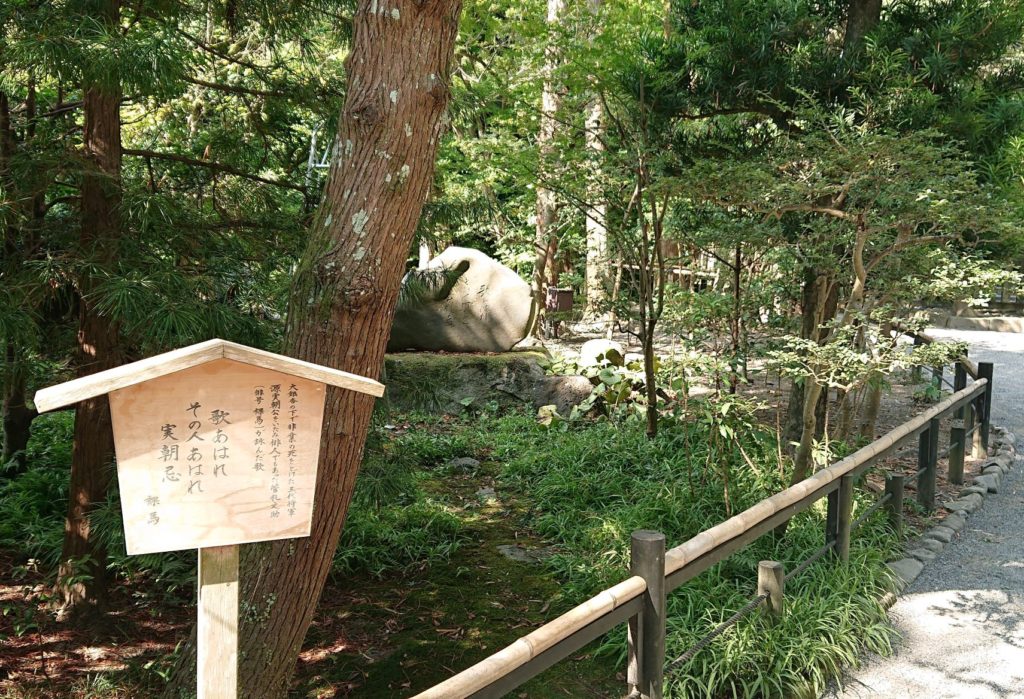
源実朝が、大銀杏の下で殺されたことを憂いて読まれた歌の石碑です。
It is a stone monument of a song that was read with fear that Sanetomo Minamoto, the third shogun was killed under a large ginkgo.
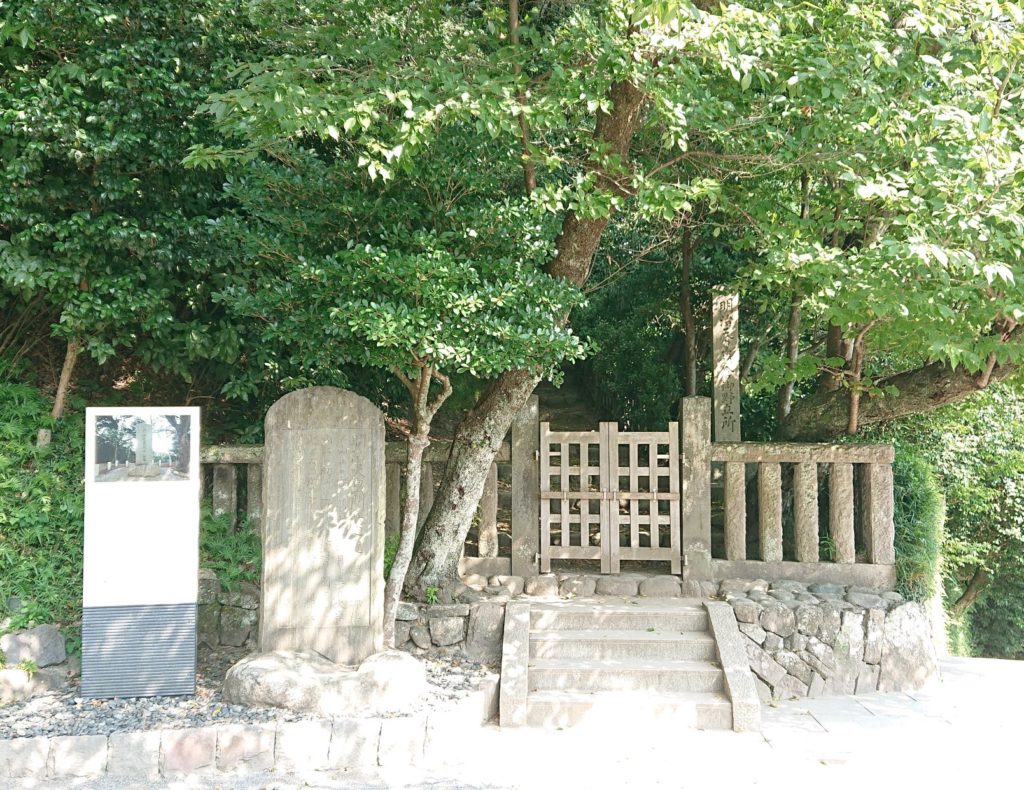
明治時代に、明治天皇が鎌倉に来られた時の記念碑が、この上に有ります。
There is a monument above when the Emperor Meiji came to Kamakura during the Meiji era.
■旗上弁財天社 / Hataage Benzaiten Sha
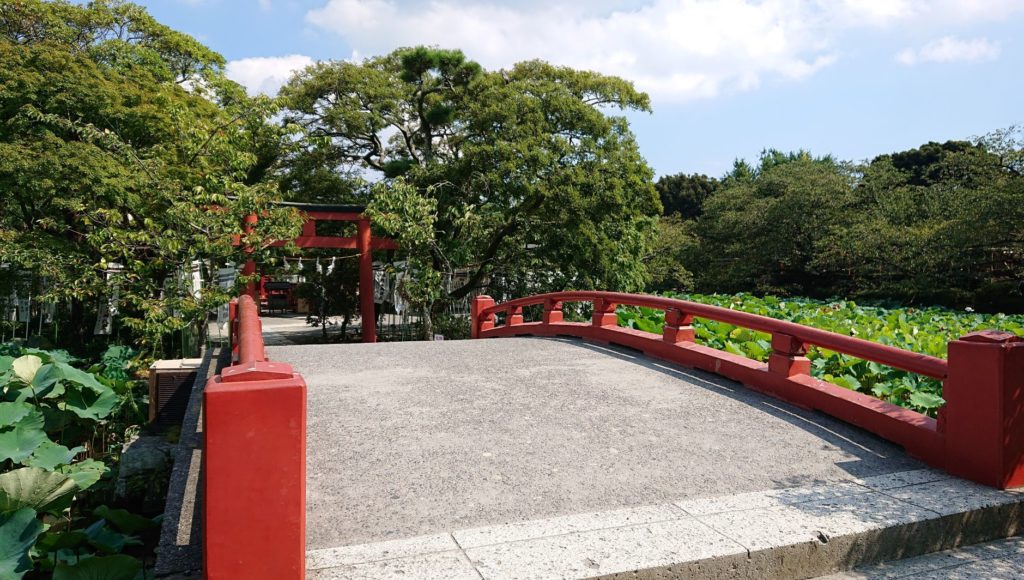
今回の目的メインにもなります。「鎌倉江の島七福神」の1つ「弁財天」へのお参りです。この「旗上弁財天社」は、「源平池」の「源氏池」側の島に建てられています。そこまでは、朱色の橋を渡ります。
It is the main purpose of this time. This is a visit to “Benzaten”, one of the “Kamakura Enoshima Seven Lucky Gods”. This “Hataage Benzaiten Sha” is built on the island of “Genji Pond” side of “Genpei Pond”. You can walk on the vermilion bridge.
渡ると、小さな境内があり、旗が所狭しと立てられています。藤の棚の下で祈願ができます。
After crossing, there is a small precinct and the flags are erected. You can pray under the wisteria shelf.

1180年、源頼朝は、伊豆国で旗上げをした。しかし、石橋山の闘いで敗れ、その後鎌倉に移り、鶴岡八幡宮を創建した。夫人である北条政子は、平家の滅亡を祈願し、源氏池と平家池を掘らせた。源氏池には、三島を配し「三は産なり」、平家池には、四島を配し、「四は死なり」とした。
In 1180 Minamoto no Yoritomo raised the flag in Izu region. However, he lost in the battle of Ishibashi Mountain, then moved to Kamakura and founded Tsurugaoka Hachimangu. His wife, Masako Hojo, prayed for the destruction of the Heike and made the Genji pond and Heike pond. In Genji pond, 3 islands is arranged and 3 pronounce is “san” . It is the same pronounce of Kanji of “birth”. In Heike pond, Four islands are arranged and 4 pronounce is “shi” . It is the same pronounce of Kanji of “death”.
そして、源氏池の1つの島に、「弁財天社」を祀ったのが始まり。その後、明治初年に神仏分離で、「弁財天社」が無くなったが、昭和31年に再興された。昭和55年に、鶴岡八幡宮800年を記念して、現在の社殿が江戸末期の古図に基づき復元された。ここに祀られている「弁財天像」は、鎌倉彫刻の代表傑作とされ人間味溢れた妙音芸能の女神となっている。
Then, it began to honor “Benzaiten Sha” on one island of Genji Pond. After that, in the first year of the Meiji era, the “Benzaiten Sha” was lost due to the separation of Shinto and Buddhism, but it was revived in 1931. In 1980, to commemorate the 800th anniversary of Tsurugaoka Hachimangu Shrine, the current shrine was restored based on an old map of the late Edo period. The “Benzaiten statue”, which is respected here, is a masterpiece of Kamakura sculpture and a goddess of humanistic performing arts.
開店、事業拡張、家内安全、商売繁盛、必勝祈願、病気平癒、縁結びなどの祈祷ができる。
You can pray for Opening, business expansion, family safety, prosperous business, prayer for victory, healing of illness, prayer for marriage, etc.
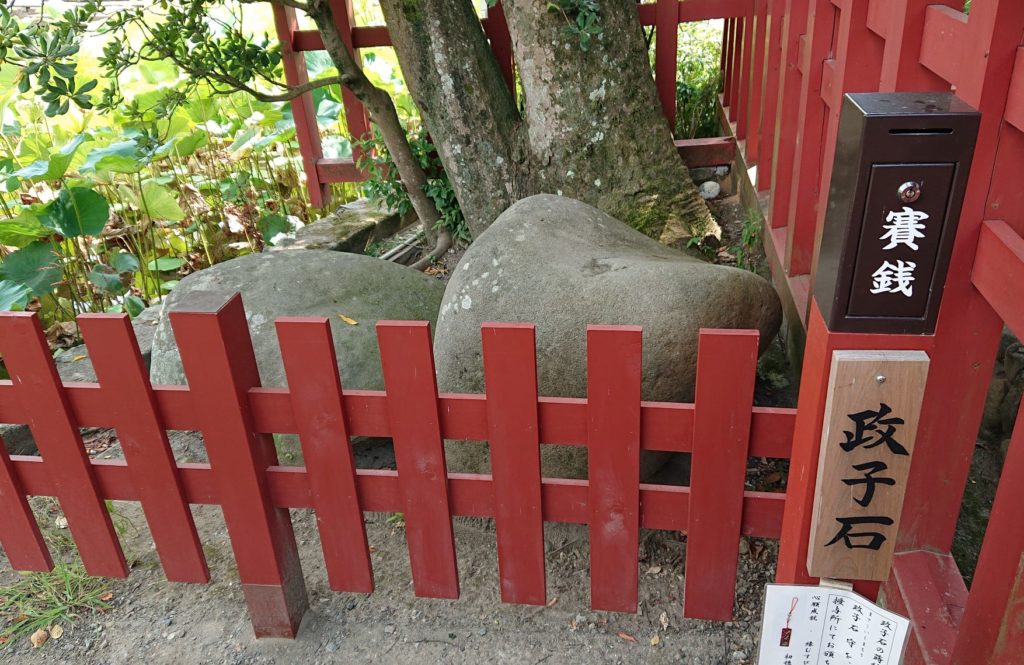
「政子石」は、「弁財天社」の裏側に位置し、夫婦円満と子宝の祈願石とされている。
“Masako stone” is located behind “Benzaiten Sha” and is said to be a prayer stone for couple’s peace and child birth.
■自お祓い / Self-Purification
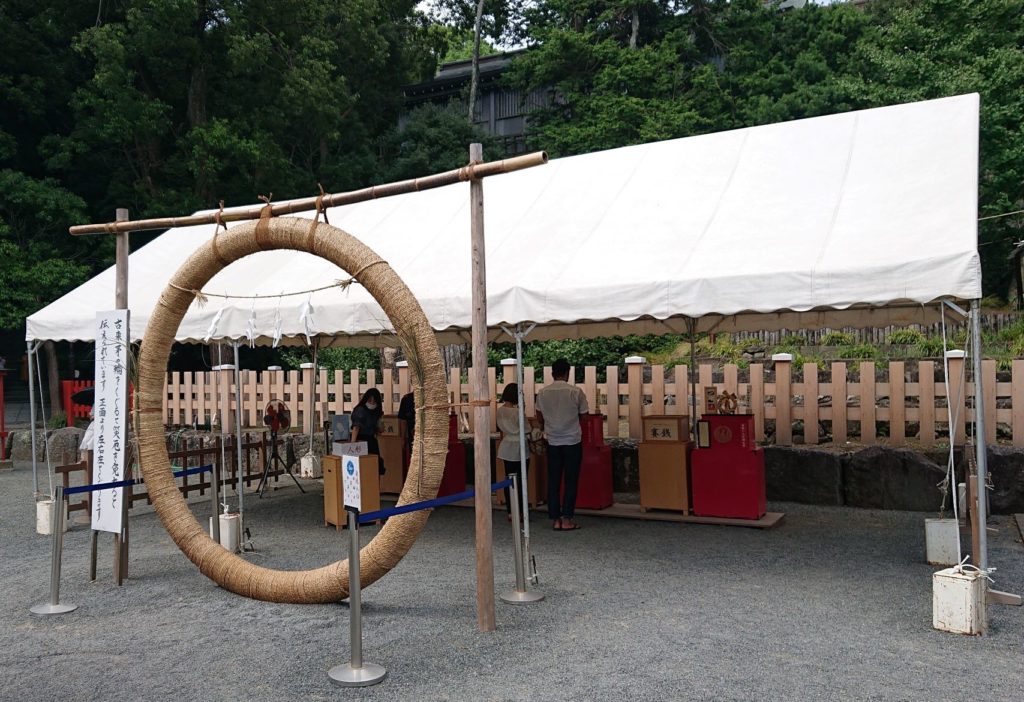
いつも見慣れないテントが、「鶴岡八幡宮」の階段の両側に張られていました。コロナ禍への対策の様です。毎年行われている「大祓式」に、一般客が参列できないために、自らお祓いをする場所を設けているとのことです。
Unusual tents were set up on both sides of the stairs at Tsurugaoka Hachimangu. It seems to be a measure against coronal viruses. It is said that there is a place for people to pray for themselves because the general public cannot attend the annual “Oharai (Great Purification)” ceremony.
まず、紙でできた人形を渡されます。
First, you will be given a doll made of paper.
- 茅の輪の真ん中から潜って
- 左回りして潜って
- 右回りして潜って
- 左回りで潜って
- お参り
- pass through from the middle of Kaya ring,
- pass through counterclockwise,
- pass through clockwise,
- pass through counterclockwise,
- and pray
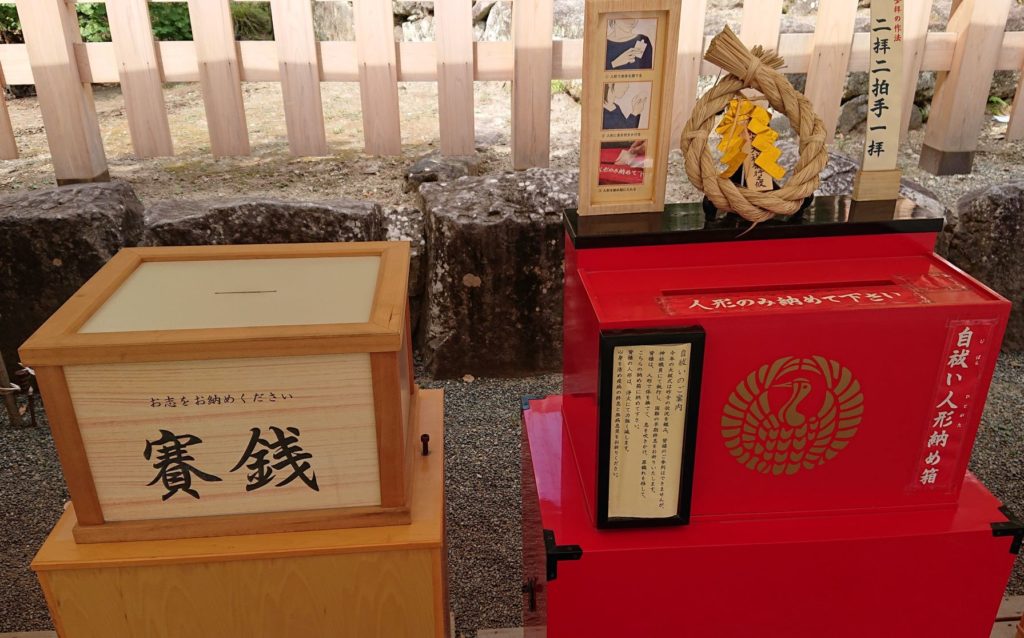
お参りの手順は、1)紙人形で体を撫でる 2)人形に息を吹きかける 3)人形を納め箱に入れる
The procedure for praying is 1) stroking the body with a paper doll, 2) blowing on the doll and 3) putting the doll in a box.
心身を清め疫病の終息と無病息災を祈ります。
Purify your body and soul and pray for the end of the plague and the illness.
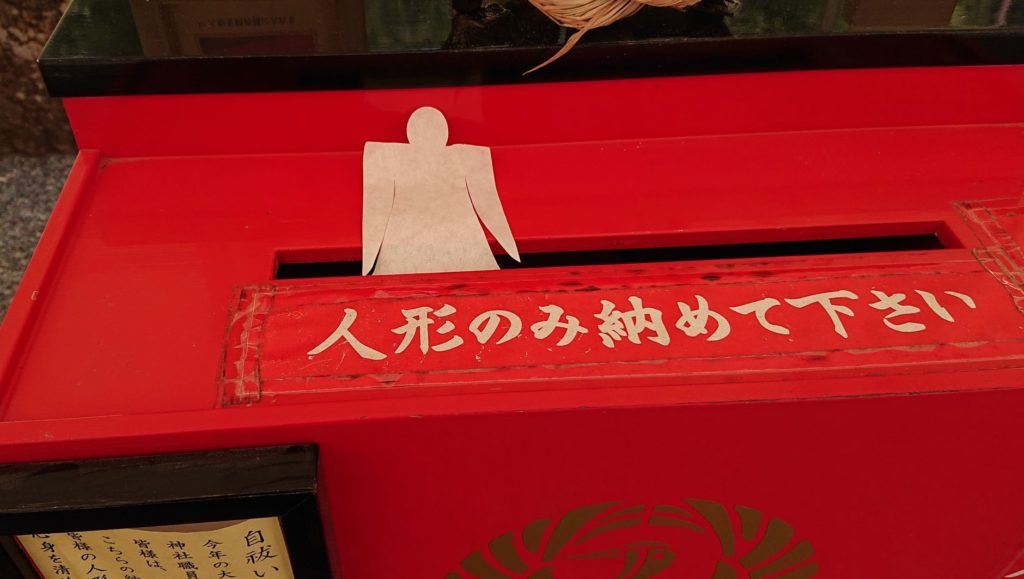
集められた人形は、浄火で力強く滅するそうです。
The collected dolls will be destroyed powerfully by the fire.
■舞殿と手水舎 / Maiden and Temizuya
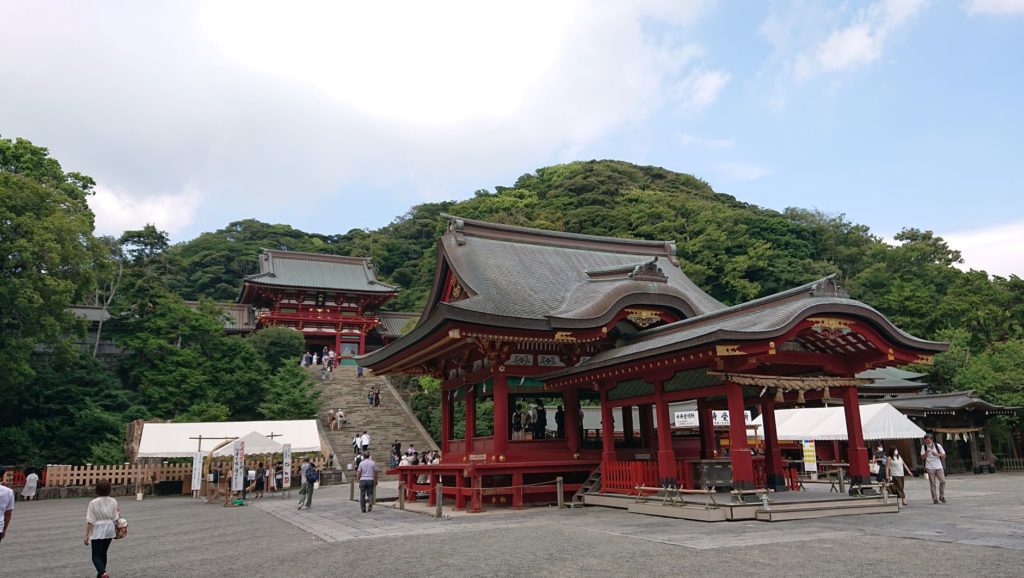
毎年「静の舞」が披露される舞台です。
It is a stage where “Shizuka no Mai” is performed every year.
元々、「静御前」は、京の白拍子。後白河法皇の命で、「雨乞いの舞」を100人の白拍子に舞わせたところ、100人目の「静御前」が3日間雨を降らせたことで名が知れます。その際に、源義経の妾となり、以降、頼朝の手から逃れる義経と行動を共にします。「静御前」は、義経と別れた後捕らえられ、鎌倉に移送されます。
Originally, “Shizuka Gozen” was “Shira Byoshi (Dancer and Performer)” in Kyoto. It is known that Pope Goshirakawa ordered 100 people to perform the “Amagoi no Mai (praying for rain)” at the order of the 100th person, and the 100th person, “Shizuka Gozen,” rained for three days. At that time, he became a concubine of Minamoto no Yoshitsune, and later she and Yoshitsune escape from elder brother Yoritomo’s control. “Shizuka Gozen” is captured after being separated from Yoshitsune and transferred to Kamakura.
その際、源頼朝の命で、舞を要求されるが断り続け、ついに、若宮で義経を想う気持ちを歌い舞ったそうです。待った場所は、「舞殿」ではなく、若宮社殿の回廊と言われています。
At that time, it was said that Minamoto no Yoritomo demanded a dance, but she refused, and at last she sang and danced in Wakamiya Shrine to sang the thought of Yoshitsune. The place you’ve been waiting for is said to be the corridor of the Wakamiya Shrine, not the Maiden.
吉野山 峰の白雪 ふみわけて 入りにし人の 跡ぞ恋しき (吉野山の白雪を踏み分けて山深くお入りになってしまった義経様が恋しい )
I miss Yoshitsune who stepped into the white snow of Yoshino mountain and entered deep into its mountain.
しづやしづ しづのをだまき くり返し 昔を今に なすよしもがな (静、静と繰り返し私の名を呼んだあの人の輝かしかった頃にもう一度戻りたい)
I want to go back that was the better days to meet with Yoshitsune who called my name “Shizu” and “Shizu” repeatedly.
源頼朝は激怒したそうだが、北条政子は、諫めたとのこと。
It seems that Minamoto no Yoritomo was furious, but Masako Hojo said he gave up.
その後、義経の男の子を出産しますが、命により殺害され、由比ガ浜に捨てられます。「静御前」は、鎌倉を離れ、京に向かったとか、由比ガ浜で身を投げたとか、消息が明らかになっていないそうです。
Later, she gave birth Yoshitsune’s bagy, but the baby was killed by Yoritomo’s order and abandoned it at Yui-ga-Hama (beach). It is said that “Shizuka Gozen” has not been known to leave Kamakura, head for Kyo, or throw herself at Yui-ga-Hama.
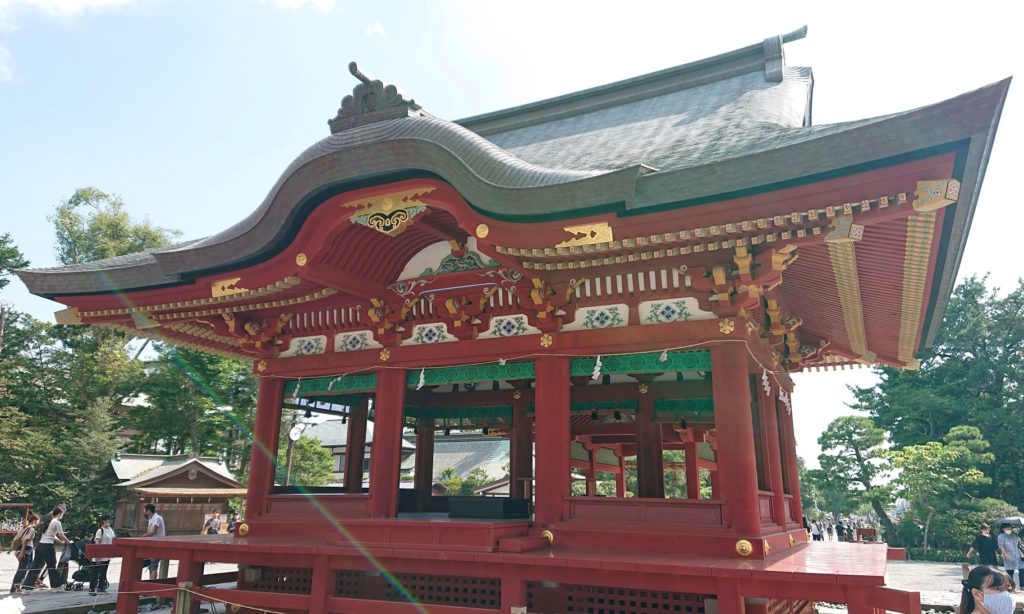
「鶴岡八幡宮」側から見た「舞殿」です。この「舞殿」では、結婚式が行われます。親戚の結婚式で、舞台に上がったことがあります。多くの人に祝福されます。
This is the “Maiden” view from the “Tsurugaoka Hachimangu” side. Weddings are held at this “Maiden”. I’ve been on stage at a relative’s wedding. Blessed by many.
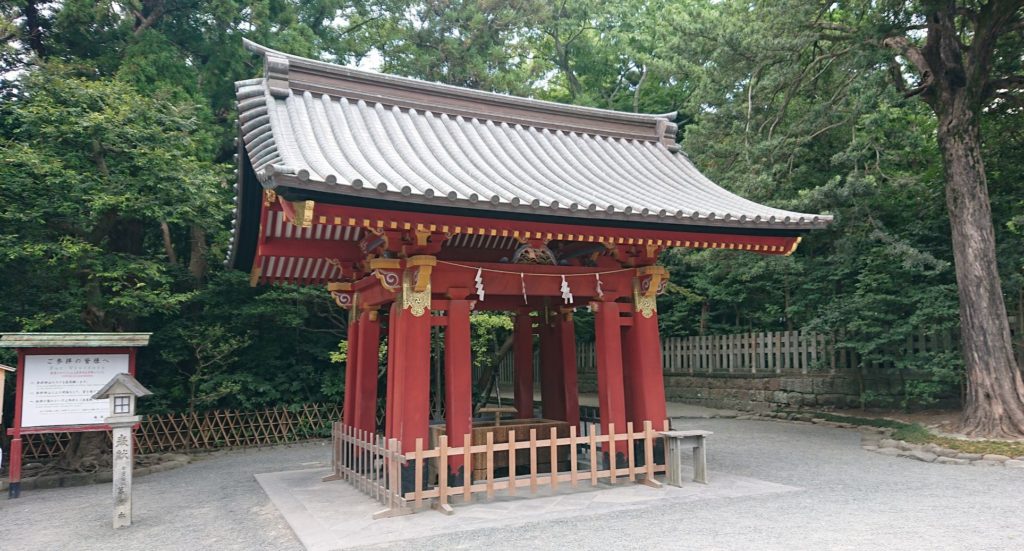
「手水舎」は、現在使えませんでした。この左側に、筒から水が出ている場所があり、そこで手を洗うだけの清めをしました。
The “Temizuya” to purify is currently unavailable. On the left side of this, there is a place where water came out of the cylinder, and I just washed my hands there.
■鶴岡八幡宮 / Tsurugaoka Hachimangu

「鶴岡八幡宮」と言えば、「大銀杏」。昔、公暁が隠れ、3代将軍源実朝を暗殺した場所です。しかし、2010年に樹齢1千年の「大銀杏」は倒れ、現在は切り株として残っています(写真手前)。現在は、子供の銀杏が成長し、3m近く成長しています(写真奥)。
Speaking of “Tsurugaoka Hachimangu,” “Great Ginkgo”. It is a place where Kugyo was hidden and assassinated the third Shogun Sanetomo Minamoto in Kamakura era. However, in 2010, the 1,000-year-old “Great Ginkgo” fell down and remains as a stump (front of the photo). Currently, a child’s ginkgo is growing to nearly 3 m (photo behind).
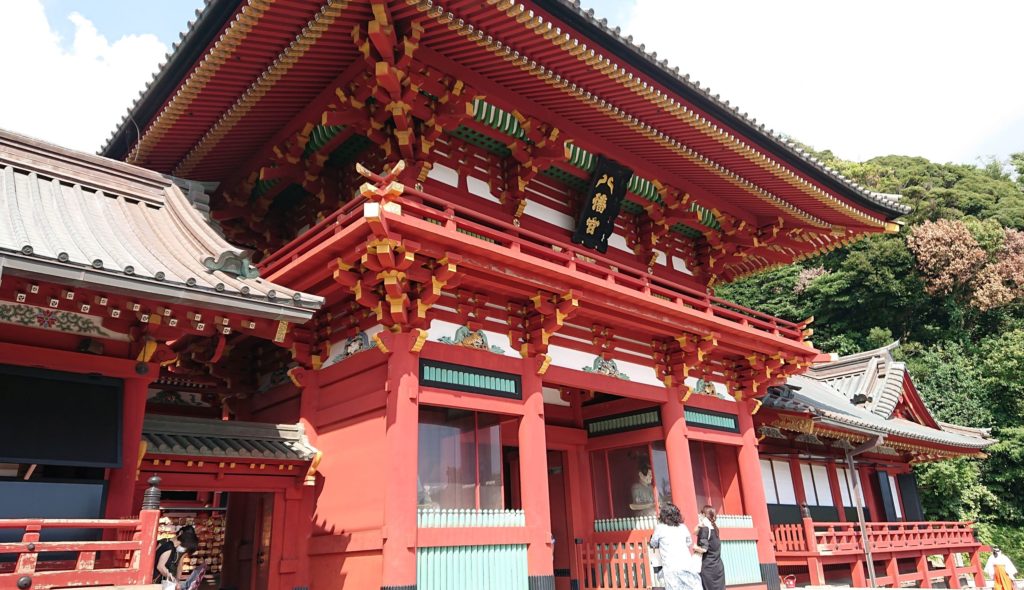
銀杏の横の階段61段を上りきると、「鶴岡八幡宮楼門」が出迎えます。ここを潜って、拝殿、幣殿、本殿があります(写真撮影禁止)。
After climbing 61 stairs next to the Ginkgo, you will be invited by the “Tsurugaoka Hachimangu Romon Gate.” After coming through the gate, there are the worship hall, the mint, and the main hall. (photographing is prohibited)
門の上の扁額の「八幡宮」の「八」は鳩の向き合う形を表しています。これは八幡神の使いが鳩であることを意味しています。
The kanji character “eight” of the flat-shaped “Hachimangu” above the gate represents the shape of a pigeon facing each other. This means that the messenger of Hachimanjin(God) is pigeon.
「鶴岡八幡宮」は、鎌倉初代将軍源頼朝ゆかりの神社です。「三大八幡」の1つと言われています。通常、下記神社の4社のうち3社を選択するそうです。
“Tsurugaoka Hachimangu” is the shrine associated with the first Shogun Kamakura general Minamoto no Yoritomo. It is said to be one of the “Great No.3 Hachiman”. Usually, 3 of the 4 shrines below are selected.
- 宇佐神宮(大分県宇佐市)
- 石清水八幡宮(京都府八幡市)
- 筥崎宮(福岡県福岡市東区)
- 鶴岡八幡宮(神奈川県鎌倉市)
- Usa Shrine (Usa City, Oita Prefecture)
- Iwashimizu Hachimangu (Hachiman City, Kyoto Prefecture)
- Hakozakigu (Higashi Ward, Fukuoka City, Fukuoka Prefecture)
- Tsurugaoka Hachimangu (Kamakura City, Kanagawa Prefecture)
鎌倉の鶴岡八幡宮の祭神は、以下の通りです。
The festival gods of Tsurugaoka Hachimangu in Kamakura are as follows.
- 応神天皇 (おうじんてんのう) 第15代天皇
- 比売神 (ひめがみ)
- 神功皇后 (じんぐうこうごう) 第14代仲哀天皇の妃、応神天皇の母
- Emperor Ojin, 15th Emperor
- Hime God
- Empress Jingu, 14th Princess of Emperor Nakaso, Mother of Emperor Ojin
Wikiによると、1063年に河内国(大阪府)を本拠地とする源頼義が、前九年の役での戦勝を祈願したのが京都の石清水八幡宮護国寺。それを源頼朝が鎌倉の由比郷鶴岡(材木座)に鶴岡若宮として勧請したのが始まりである。1208年には神宮寺が創建される。
According to the Wiki, in 1063, Minamoto no Yoriyoshi, who is based in Kawachi Province (Osaka Prefecture), prayed for victory in in “the nine years war” at Iwashimizu Hachimangu Gokokuji Temple in Kyoto. It started when Minamoto no Yoritomo entrusted it to Yuigo Tsurugaoka, Kamakura as a Tsurugaoka Wakamiya. Jinguji Temple was founded in 1208.
鎌倉時代後は、衰退していきますが、江戸幕府の庇護を受け大規模化がされます。しかし、明治時代に神仏分離で再び衰退し、ほぼ今の規模になっています。
Although Tsurugaoka Hachimangu declined after the Kamakura era, it was scaled up under the patronage of the Edo Shogunate. However, the scale of the shrine and Buddhism separated again during the Meiji era, and the scale is now almost the same.
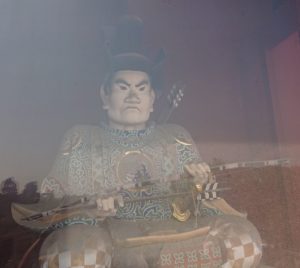
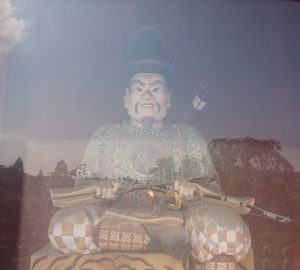
「鶴岡八幡宮楼門」の入口両側にある像です。
There are statues on both sides of the entrance of “Tsuruoka Hachimangu Romon Gate”.
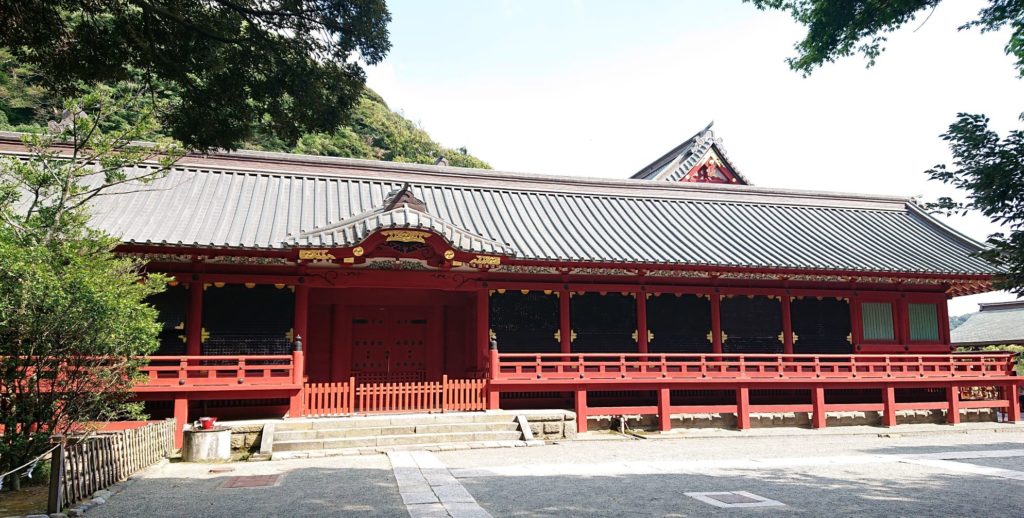
本殿の西側に、「宝物殿」があります。入場料を払えば、宝物を見ることができます。その「宝物殿」の入口は、本殿側(内側)です。この写真の左側に、「宇佐神宮逢拝所」があります。
There is a “Treasure Hall” on the west side of the main hall. If you pay the entrance fee, you can see the treasure. The entrance to the “Treasure Hall” is on the main hall side (inside). To the left of this photo is the Usa Jingu Yohaijo.
■丸山稲荷社 / Maruyama Inari Shrine
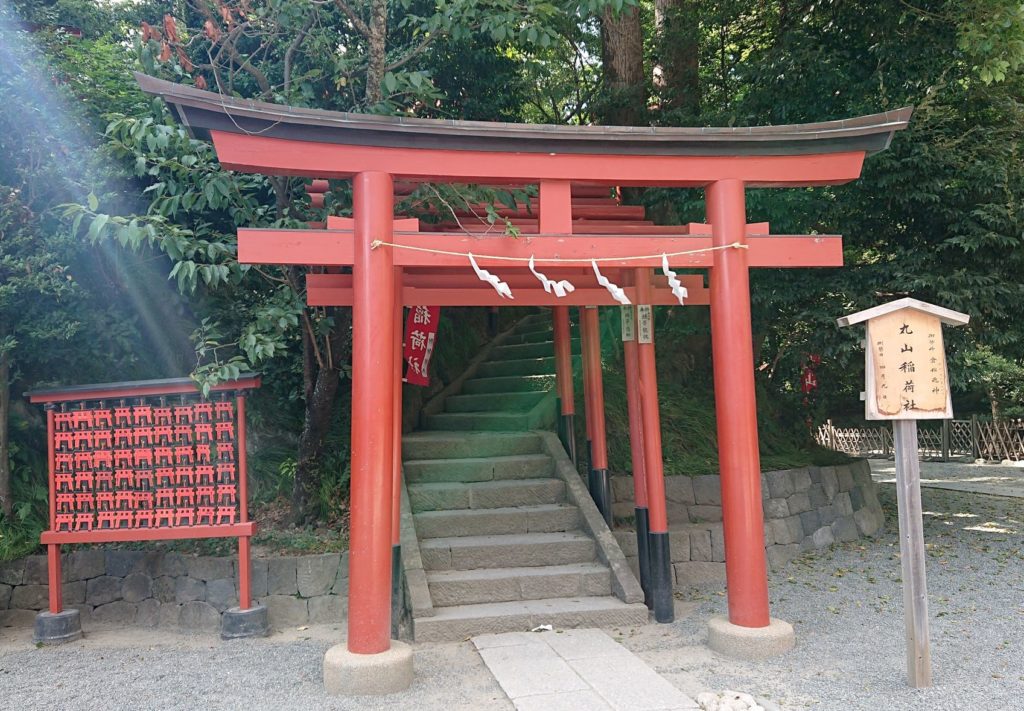
「宝物殿」の向かいに、「丸山稲荷社」があります。鳥居に囲まれた階段を1分弱上っていくと、こじんまりとした境内の中に社があります。
There is “Maruyama Inari Sha” opposite the “Treasure Hall”. If you go up the stairs surrounded by many torii gates for less than 1 minute, you will find the shrine in a small precinct.
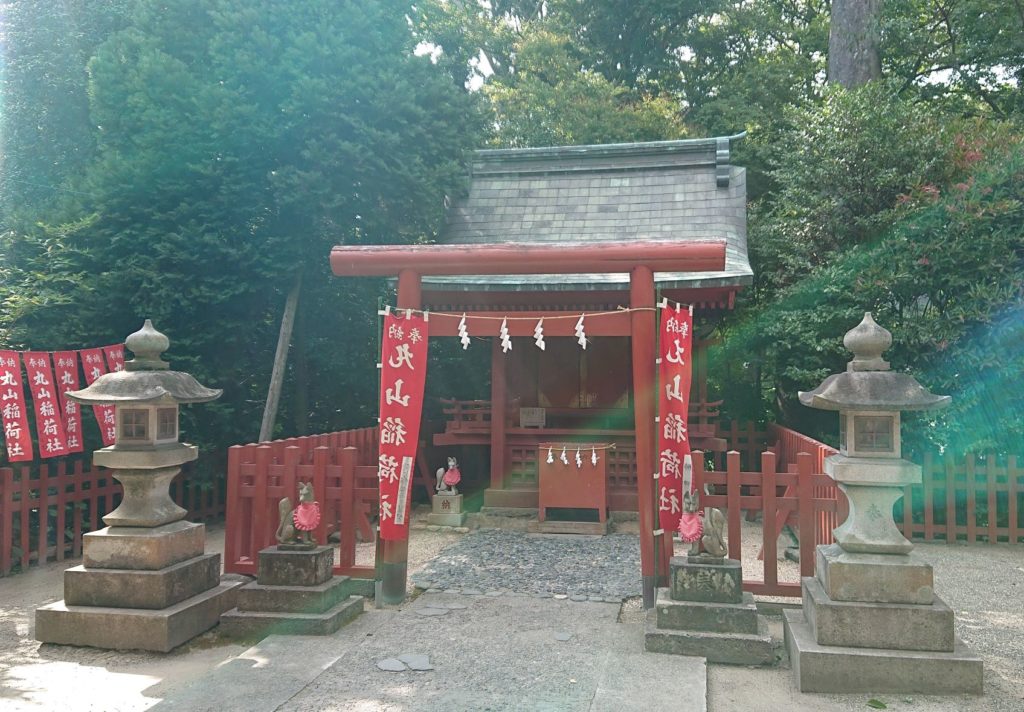
鶴岡八幡宮で最も古い室町期の建物で、社殿は商売繁昌を祈願する方から奉納された赤い旗で囲まれている。
This is the oldest building in the Muromachi period at Tsurugaoka Hachimangu, and the shrine is surrounded by red flags dedicated to those who pray for prosperous business.
■若宮(下宮) / Wakamiya
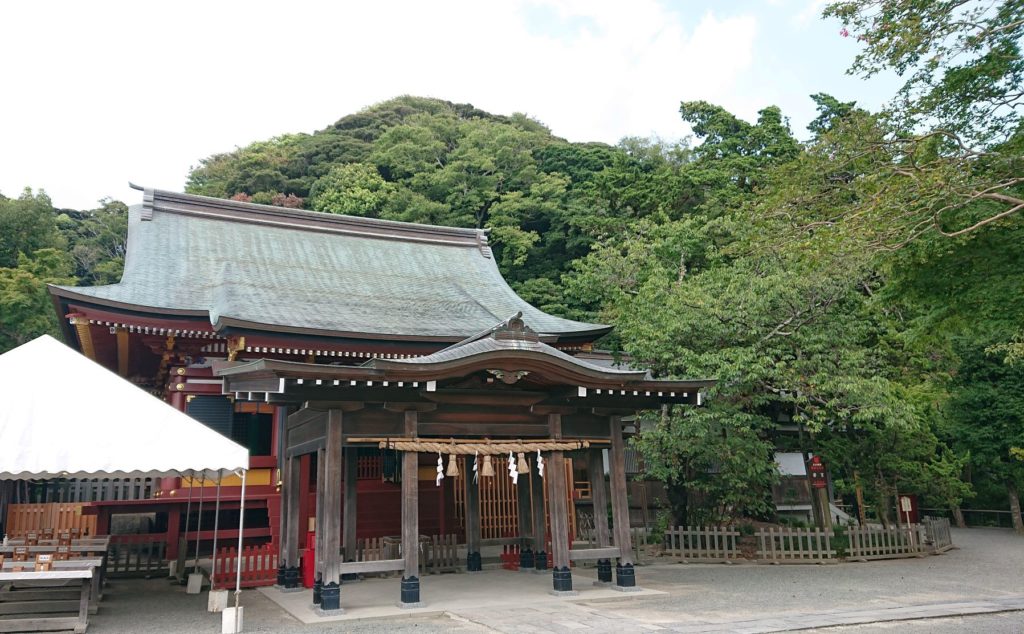
「若宮」の祭神は、仁徳天皇など3柱です。
There are three pillars (festival Gods) of wakamiya, including Emperor Nintoku.
源頼朝が、材木座の「由比若宮」を、この位置に移し「鶴岡若宮」と呼ばれていました。1191年に焼失した際に、今の本殿を建てるとともに、「若宮」も再建されました。1624年に現在の社殿が建てられ、重要文化財になっています。その時の社殿は、菅原道真を祭神とする荏柄天神社(東側に500m)に移築され唯一の鎌倉建築として残っています。
Minamoto no Yoritomo moved the “Yui Wakamiya” in Zaimokuza region to this position and called it “Tsurugaoka Wakamiya.” When it was burnt down in 1191, the main hall was built newly and the “Wakamiya” was rebuilt. The current shrine was built in 1624 and has become an important cultural property. The shrine at that time was relocated to Egara Tenjin Shrine (500m on east), where Michizane Sugawara is the deity, and remains as the only Kamakura architecture.
ここの回廊で、「静御前」が実際に舞ったと言われています。現在は、結婚式の控室などに使われています。
It is said that “Shizuka Gozen” actually danced in the corridor here. Currently, it is used for wedding waiting rooms.
■白旗神社 / Shirohata Shrine
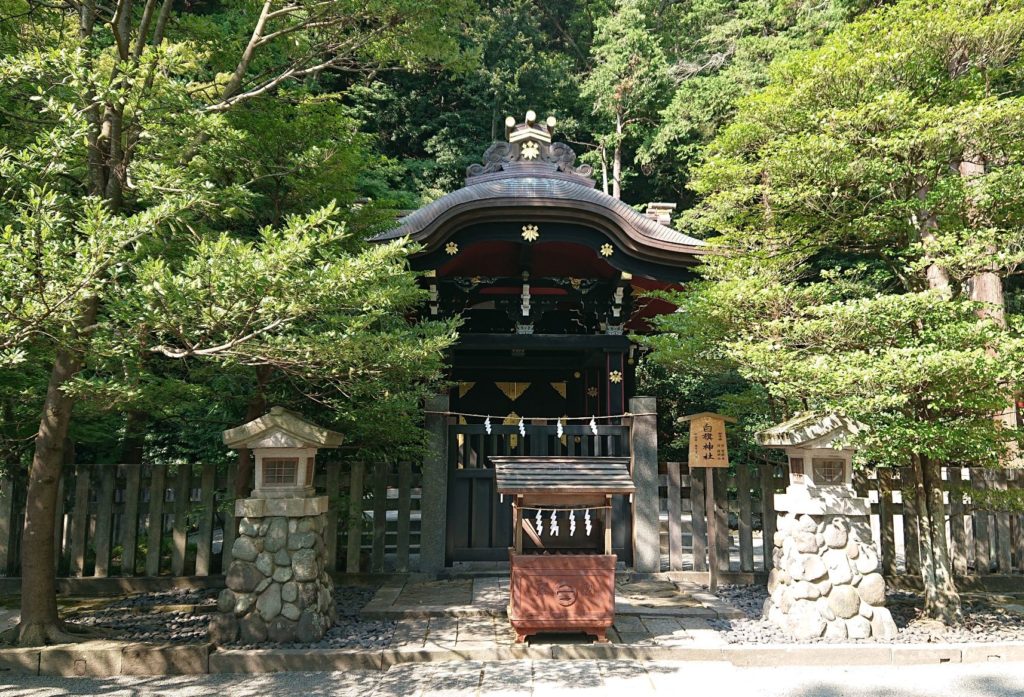
源氏の白旗にちなんだ神社で、祭神は、源頼朝、源実朝になります。北条政子が建てたと言われています。白旗神社は、全国各地に存在する。
The shrine is named after the white flag of Genji, and the deities of the festival are Minamoto no Yoritomo and Minamoto no Sanetomo. It is said that Masako Hojo built it. Shirohata Shrine exists all over the country.
逸話として、豊臣秀吉が、白旗神社に訪れた際に、祀られている源頼朝像に対して、「微小な身の育ちでありながら天下をとったのは、御身と吾だけである。しかし、御身の先祖は関東で威をはり、挙兵すれば多くの兵が従い天下をとるのも容易であったろうが、吾は名もない卑属から天下をとったのだから、吾の方が出世頭である」といったそうである。その後、「御身と吾は天下友達である」といって像の背中を叩いたと伝えられています。
As an anecdote, when Hideyoshi Toyotomi visited the Shirohata Shrine, he said to the enshrined Minamoto no Yoritomo statue, “The only ones who have grown up in spite of their small physical growth are the Gods. Your ancestors were powerful in the Kanto region, and it would have been easy for many soldiers to follow you if you raised the army. But I took the top of Japan from bottom level. After that, it is said that he struck the back of the statue saying, “You and I are friends as the top of the Japan.”
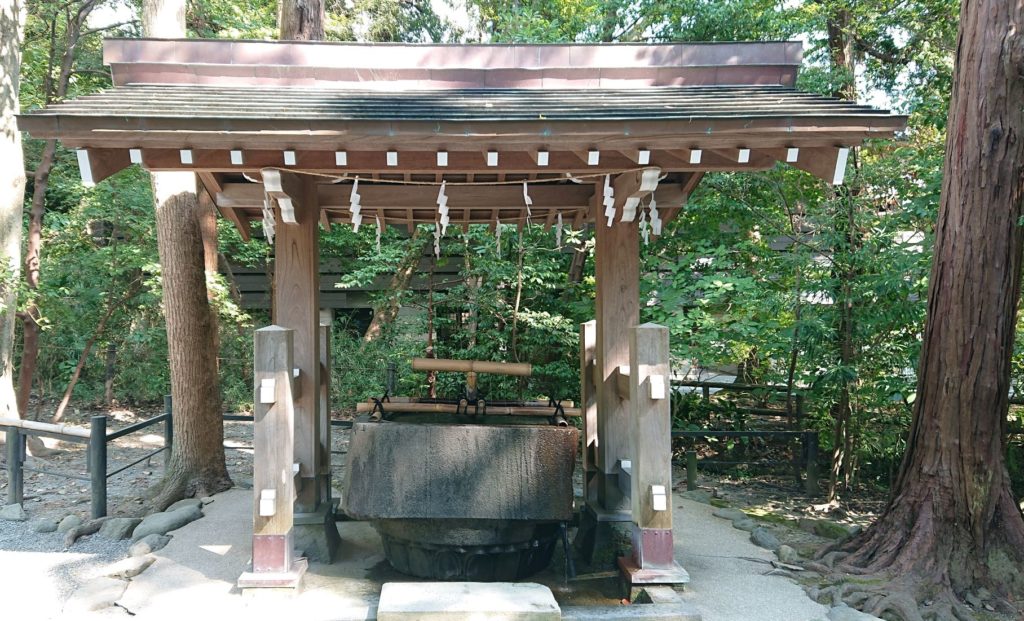
白旗神社の手水舎の水盤には蓮弁の彫刻があります。明治の仏神分離を経て、神舎の「手水舎」と仏教の「蓮」が混在していることから、かつて、この地が神仏混淆時代の「鶴岡八幡宮寺」であった頃の名残とみられています。
There is a lotus flower sculpture on the basin of the Temizusha at Shirohata Shrine. The fact that the shrine “Temizuya” and the Buddhist “Lotus” have been mixed after the separation of the Buddhist gods in the Meiji era is evidence that this place was once “Tsurugaoka Hachimangu-ji temple” during the God-Buddha mixed era.
■今宮 / Imamiya
今回、行っていないのですが、「今宮」の祭神は、承久の乱で流刑された、後鳥羽天皇、土御門天皇、順徳天皇です。
I haven’t been “Imamiya” this time, but the gods of “Imamiya” are Emperor Gotoba, Emperor Tsuchimikado, and Emperor Juntoku, who were exiled in the Gyoku Revolt.
次回行った際に情報のアップデートをします。
I will update the information the next time I go.
■まとめ / Summary
「鎌倉江の島七福神」の1つ「旗上弁財天社」「丸山稲荷神社」「白旗神社」に足を運べたことは良かったです。このブログを書くことで、それぞれの云われも理解することができ、良い機会でした。
It was nice to be able to visit one of the “Kamakura Enoshima Seven Lucky Gods” “Hataage Benzaiten”, “Maruyama Inari Shrine” and “Shirohata Shrine”. By writing this blog, I was able to understand each buildings and it was a good opportunity.
コロナ禍の影響で、特設「自お祓い」で、貴重な体験ができました。
Due to the influence of Corona, I had a valuable experience at the special “Self Purification”.
事前勉強をせずに行ってしまったので、行きそびれた所が数か所あり、次回訪れたいと思います。
I went without studying in advance, so I missed some places and would like to visit there next time.
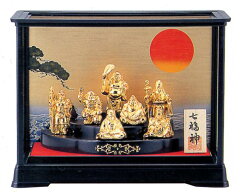



この記事へのコメント